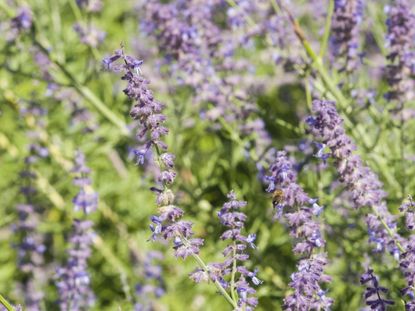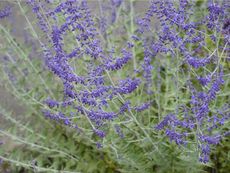Container Grown Russian Sage: How To Grow Russian Sage In A Pot


Russian sage (Perovskia) is a woody, sun-loving perennial that looks spectacular in mass plantings or along a border. If you’re short on space or you need a little something to fancy up a deck or patio, you can definitely grow Russian sage in containers. Sound good? Read on to learn more about container-grown Russian sage.
How to Grow Russian Sage in a Pot
When it comes to growing Russian sage in containers, bigger is definitely better because a large pot provides ample space for the roots to develop. Russian sage is a tall plant, so use a pot with a sturdy base. Any pot is fine as long as it has at least one drainage hole in the bottom. A paper coffee filter or a piece of mesh screening will keep the potting mix from washing through the drainage hole. Use a lightweight, well-drained potting mix. Potted Russian sage is likely to rot in soggy, poorly drained soil. A standard potting mix combined with a bit of sand or perlite works well.
Care for Russian Sage in a Container
Water potted Russian sage often during hot, dry weather as potted plants dry out quickly. Water at the base of the plant until the extra trickles through the drainage hole. Don’t water if the soil still feels moist from the previous watering. A potting mix with fertilizer premixed at planting time will provide the plant with nutrients for six to eight weeks. Otherwise, fertilize potted Russian sage every couple of weeks with a dilute solution of a general purpose, water-soluble fertilizer. Trim Russian sage to 12 to 18 inches (31-46 cm.) in spring. If you’re sure all danger of frost has passed, you can trim a little harder. You can also trim lightly throughout the season. Although you can trim Russian sage in fall, this isn’t a wise practice in cold climates when trimming may produce tender new growth that can get nipped by frost during the winter months. Also, the plant provides attractive texture to the garden (and shelter for birds) during the winter months. Stake the plant if it becomes top-heavy.
Caring for Potted Russian Sage in Winter
Russian sage is a durable plant suitable for growing in USDA plant hardiness zones 5 through 9, but plants in containers are less cold hardy. If you live in the northern reaches of that climate range, you may need to offer potted Russian sage a bit of extra protection during the winter months. You can bury a non-freezing container in a protected area of your garden and pull it out in spring, but the easiest way to save Russian sage in containers is to bring the plant into an unheated (non-freezing) shed, garage, or another area. Water lightly as needed to keep the potting mix from becoming bone dry. Your other option is to simply treat Russian sage as an annual and let nature take its course. If the plant freezes, you can always start with new plants in spring.
Gardening tips, videos, info and more delivered right to your inbox!
Sign up for the Gardening Know How newsletter today and receive a free download of our most popular eBook "How to Grow Delicious Tomatoes."

A Credentialed Garden Writer, Mary H. Dyer was with Gardening Know How in the very beginning, publishing articles as early as 2007.
-
 Grow a Bathroom Oasis: 8 Best Bathroom Plants With No Light or Low Light
Grow a Bathroom Oasis: 8 Best Bathroom Plants With No Light or Low LightSome apartment dwellers grow the best bathroom plants with no light or low light. Read how one of our favorite plant lovers does it in the big city.
By Teo Spengler
-
 "My Worst Mistake" – Gardeners Share 10 Hard-Learned Lessons
"My Worst Mistake" – Gardeners Share 10 Hard-Learned LessonsGardeners never stop learning, and sometimes our mistakes are the best teachers. But why not save time and heartache by learning from other gardeners' failures?
By Melanie Griffiths
